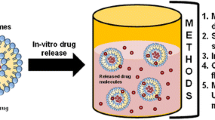Abstract
Doxil® is a complex parenteral doxorubicin (DOX) liposome formulation approved by the FDA. For generic doxorubicin liposomes, analyzing the release profile of DOX is important for quality control and comparability studies. However, there is no robust standard drug release assay available for doxorubicin liposomes. In this study, we describe a USP-4 apparatus assay capable of discriminating DOX liposomal formulations based on release profile. Establishment of the assay was hindered by limited DOX release from liposomes in physiological conditions at 37°C. The addition of NH4HCO3 to the release media facilitated DOX release proportionally to the salt concentration added but caused precipitation of released drug in USP-4 apparatus. Precipitation of DOX was avoided by adding hydroxypropyl-cyclodextrin (HP-CD) to the release medium. We optimized conditions for DOX release by varying a number of parameters such as: concentration of HP-CD, testing temperature, and concentration of tested samples. The optimized release medium contained: 100 mM NH4HCO3, 75 mM 2-(N-morpholino) ethanesulfonic acid (MES) and 5% w/v HP-CD, 5% w/v sucrose, 0.02% w/v NaN3 (pH 6). The drug release assay was performed at 45°C. The optimized release assay can discriminate between DOX liposomal formulations of different compositions, physicochemical properties, and prepared by different manufacturing methods. This indicates that the assay could be used to compare DOX release from generic DOX formulations to the innovator product Doxil®.






Similar content being viewed by others
References
Gabizon AA. Pegylated liposomal doxorubicin: metamorphosis of an old drug into a new form of chemotherapy. Cancer Investig. 2001;19(4):424–36.
Barenholz Y. Doxil®—the first FDA-approved nano-drug: lessons learned. J Control Release. 2012;160(2):117–34.
Niu G, Cogburn B, Hughes J. Preparation and characterization of doxorubicin liposomes. Methods Mol Biol. 2010;624:211–9.
FDA approval of generic version of cancer drug Doxil is expected to help resolve shortage. 2013; Available from: http://www.fda.gov/NewsEvents/Newsroom/PressAnnouncements/ucm337872.htm.
Draft guidance on doxorubicin hydrochloride. 2014; Available from: http://www.fda.gov/downloads/Drugs/…/Guidances/UCM199635.pdf.
Bhardwaj U, Burgess DJ. A novel USP apparatus 4 based release testing method for dispersed systems. Int J Pharm. 2010;388(1–2):287–94.
Rawat A, Bhardwaj U, Burgess DJ. Comparison of in vitro-in vivo release of Risperdal(®) Consta(®) microspheres. Int J Pharm. 2012;434(1–2):115–21.
Rawat A, Burgess DJ. USP apparatus 4 method for in vitro release testing of protein loaded microspheres. Int J Pharm. 2011;409(1–2):178–84.
Rawat A, Stipper E, Shah VP, Burgess DJ. Validation of USP apparatus 4 method for microsphere in vitro release testing using Risperdal ® Consta ®. Int J Pharm. 2011;420(2):198–205.
Glavas-Dodov M, Goracinova K, Mladenovska K, Fredro-Kumbaradzi E. Release profile of lidocaine HCl from topical liposomal gel formulation. Int J Pharm. 2002;242(1–2):381–4.
Ruozi B, Tosi G, Forni F, Angela Vandelli M. Ketorolac tromethamine liposomes: encapsulation and release studies. J Liposome Res. 2005;15(3–4):175–85.
Vemuri S, Yu CD, Pushpala S, Roosdorp N. Drug release rate method for a liposome preparation. Drug Dev Ind Pharm. 1991;17(2):183–92.
Xiao C, Qi X, Maitani Y, Nagai T. Sustained release of cisplatin from multivesicular liposomes: potentiation of antitumor efficacy against S180 murine carcinoma. J Pharm Sci. 2004;93(7):1718–24.
Hitzman CJ, Wiedmann TS, Dai H, Elmquist WF. Measurement of drug release from microcarriers by microdialysis. J Pharm Sci. 2005;94(7):1456–66.
Bartlett GR. Phosphorus assay in column chromatography. J Biol Chem. 1959;234(3):466–8.
Stevens RE, Gray V, Dorantes A, Gold L, Pham L. Scientific and regulatory standards for assessing product performance using the similarity factor, f2. AAPS J. 2015;17(2):301–6.
Waiver of in vivo bioavailability and bioequivalence studies for immediate-release solid oral dosage forms based on a biopharmaceutics classification system. 2015; Available from: http://www.fda.gov/downloads/Drugs/Guidances/ucm070246.pdf.
Saranadasa H, Krishnamoorthy K. A multivariate test for similarity of two dissolution profiles. J Biopharm Stat. 2005;15(2):265–78.
Koynova R, Caffrey M. Phases and phase transitions of the phosphatidylcholines. Biochim Biophys Acta. 1998;1376(1):91–145.
Lichtenberg D, Barenholz Y. Liposomes: preparation, characterization, and preservation. Methods Biochem Anal. 1988;33:337–462.
Silverman L, Barenholz Y. In vitro experiments showing enhanced release of doxorubicin from Doxil® in the presence of ammonia may explain drug release at tumor site. Nanomed Nanotechnol. 2015;11(7):1841–50.
Haran G, Cohen R, Bar LK, Barenholz Y. Transmembrane ammonium sulfate gradients in liposomes produce efficient and stable entrapment of amphipathic weak bases. Biochim Biophys Acta. 1993;1151(2):201–15.
Barenolz Y, Haran G; Yissum. Method of amphiphatic drug loading in liposomes by pH gradient. United States Patent US5192549 A. 1993.
Gould S, Scott RC. 2-Hydroxypropyl-beta-cyclodextrin (HP-beta-CD): a toxicology review. Food Chem Toxicol. 2005;43(10):1451–9.
Guo LS, Hamilton RL, Goerke J, Weinstein JN, Havel RJ. Interaction of unilamellar liposomes with serum lipoproteins and apolipoproteins. J Lipid Res. 1980;21(8):993–1003.
Shen J, Burgess DJ. Accelerated in vitro release testing of implantable PLGA microsphere/PVA hydrogel composite coatings. Int J Pharm. 2012;422(1–2):341–8.
Shen J, Lee K, Choi S, Qu W, Wang Y, Burgess DJ. A reproducible accelerated in vitro release testing method for PLGA microspheres. Int J Pharm. 2016;498(1–2):274–82.
Acknowledgments
This project was supported by FDA grant U01 FD004893. Yue Yuan was supported by grant 81202481 of National Natural Science for Youth Foundation of China and grant GGJJ2014102 of Scientific Research Foundation for the Returned Overseas Chinese Scholars by Shenyang Pharmaceutical University.
Author information
Authors and Affiliations
Corresponding author
Additional information
Disclaimer: The views expressed in this article are those of the authors (Nan Zheng and Wenlei Jiang) and not necessarily those of the Food and Drug Administration (FDA).
Electronic supplementary material
Below is the link to the electronic supplementary material.
ESM 1
(PDF 341 kb)
Rights and permissions
About this article
Cite this article
Yuan, W., Kuai, R., Dai, Z. et al. Development of a Flow-Through USP-4 Apparatus Drug Release Assay to Evaluate Doxorubicin Liposomes. AAPS J 19, 150–160 (2017). https://doi.org/10.1208/s12248-016-9958-2
Received:
Accepted:
Published:
Issue Date:
DOI: https://doi.org/10.1208/s12248-016-9958-2




